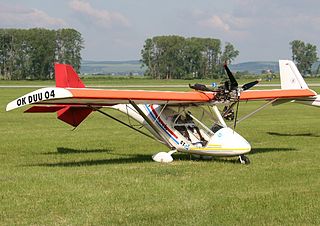The Aero A.21 was a biplane military trainer aircraft developed in Czechoslovakia from the Aero A.11 reconnaissance-bomber. The aircraft was developed specifically as a night-trainer, to teach Czech Air Force pilots instrument flying techniques.

The Aero A.29 was a military biplane developed in Czechoslovakia from the ubiquitous Aero A.11 reconnaissance-bomber. Aero equipped it with floats and it served as a target tug for training anti-aircraft gunners.

The Focke-Wulf A 20 Habicht was an airliner developed in Germany in the late 1920s. It was a high-wing cantilever monoplane with fixed tailskid undercarriage. The fuselage was deep and seated four passengers in a fully enclosed cabin. The type was not bought by the airlines and only a few examples were built.

The IS-4 Jastrząb was a single-seat aerobatic glider designed and built in Poland from 1949.

The Wassmer WA-30 Bijave is a French two-seat advanced training glider designed and built by Wassmer Aviation of Issoire.
The Aeros Mister X is a Ukrainian single-place, paraglider that was designed and produced by Aeros of Kiev.
The Aeros Still is a Ukrainian single-surface ultralight trike wing, designed and produced by Aeros of Kiev. The wing is widely used on Aeros trikes as well as by other ultralight aircraft manufacturers.
The Amax Vixen 105 is an Australian homebuilt aircraft that was designed and produced by Amax Engineering of Donvale, Victoria. When it was available the aircraft was supplied as a kit for amateur construction.

The Eurofly Fire Fox is an Italian ultralight aircraft designed and produced by Eurofly srl of Galliera Veneta. The aircraft is supplied as a complete ready-to-fly-aircraft or as a kit for amateur construction.
The Eurofly Fire Cat is an Italian ultralight aircraft that was designed and produced by Eurofly srl of Galliera Veneta. Now out of production, when it was available the aircraft was supplied as a complete ready-to-fly-aircraft or as a kit for amateur construction.
The ICP Amigo is an Italian homebuilt aircraft that was designed and produced by ICP srl of Piovà Massaia. When it was available the aircraft was supplied as a kit for amateur construction.

The Letov ST-4 Aztek is a Czech microlight aircraft that was designed and produced by Letov Kbely of Prague - Letňany, in the 1990s. When it was available, the aircraft was supplied as a complete ready-to-fly aircraft, or as a kit for amateur construction.
The Storm 320E, sometimes written Storm 320 E, is an Italian microlight aircraft that was designed and produced by Storm Aircraft of Sabaudia. Storm Aircraft was originally called SG Aviation srl. When it was available the aircraft was supplied as a kit for amateur construction.
The Tech Aero TR 200 is a French homebuilt aerobatic aircraft that was designed and produced by Tech Aero of Glisolles, first flown in August 1988. When it was available the aircraft was supplied as a kit for amateur construction.
The V-STOL XC 2000T is an American homebuilt and ultralight trainer aircraft that was designed and produced by V-STOL Aircraft of Fort Myers, Florida, introduced in the fall of 1997. When it was available the aircraft was supplied as a kit for amateur construction.

The Warner Revolution II, also marketed as the Space Walker II, is an American homebuilt aircraft that was designed and produced by Warner Aerocraft of Seminole, Florida. When it was available the aircraft was supplied as a kit or in the form of plans for amateur construction.

The Bede BD-12 was an American homebuilt aircraft designed by Jim Bede and produced by Bede Aircraft of Medina, Ohio, introduced in the 1990s. The aircraft was intended to be supplied as a kit for amateur construction, but only one was ever built.

The InterPlane Starboy was a proposed Czech homebuilt aircraft designed by InterPlane Aircraft of Zbraslavice. The aircraft was intended to be supplied as a complete ready-to-fly-aircraft or as a kit for amateur construction, but none seem to have been built.

The Performance Aircraft Formula GT is an American homebuilt aircraft that was designed and produced by Performance Aircraft of Olathe, Kansas, introduced in the 1990s. When it was available the aircraft was supplied as a kit for amateur construction.
The Vancil Spitz S1 is an American homebuilt aircraft that was designed and produced by A. Vancil of Belton, South Carolina, introduced in the late 1990s. When it was available the aircraft was supplied as a kit and also in the form of plans for amateur construction.













